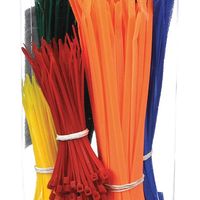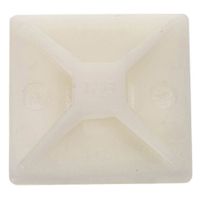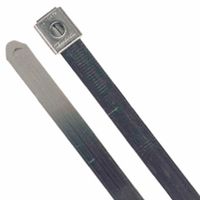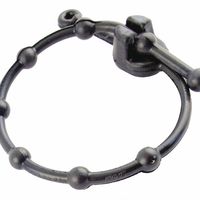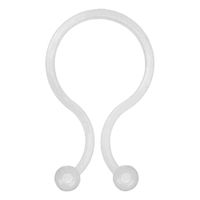Call +(254) 703 030 000 / 751 483 999 / 721 704 777
- Home
- Electrical
- Wire Cable Management
- Cable Ties Mounts
.....Read More
Frequently Asked Questions
What are the different types of cable ties and their uses?
Cable ties, also known as zip ties, come in various types, each designed for specific applications:
1. **Standard Cable Ties**: Made from nylon, these are the most common and versatile, used for bundling cables and wires in homes and offices.
2. **Releasable Cable Ties**: Feature a tab that allows them to be reused, ideal for temporary bundling or when adjustments are needed.
3. **Heavy-Duty Cable Ties**: Thicker and stronger, used for securing heavy objects or large bundles, often in industrial settings.
4. **Colored Cable Ties**: Available in various colors for color-coding and organizing cables, useful in complex wiring systems.
5. **Stainless Steel Cable Ties**: Resistant to extreme temperatures and corrosion, used in harsh environments like marine or chemical industries.
6. **UV-Resistant Cable Ties**: Made from UV-stabilized materials, suitable for outdoor use where exposure to sunlight is a factor.
7. **Flame-Retardant Cable Ties**: Designed to resist ignition, used in environments where fire safety is a concern, such as in electrical installations.
8. **Mountable Head Cable Ties**: Have a hole in the head for mounting to walls or panels, used for securing cables in fixed positions.
9. **Double-Headed Cable Ties**: Feature two loops for organizing multiple bundles separately, useful in complex wiring systems.
10. **Marker Cable Ties**: Include a tag for labeling, aiding in identification and organization of cables.
11. **Velcro Cable Ties**: Reusable and adjustable, ideal for frequently changed setups like home entertainment systems.
12. **Beaded Cable Ties**: Feature a series of beads for adjustable tension, used for gentle bundling of delicate items.
Each type of cable tie is designed to meet specific needs, ensuring secure and efficient cable management across various applications.
How do I choose the right size and strength of cable tie for my application?
To choose the right size and strength of cable tie for your application, consider the following factors:
1. **Bundle Diameter**: Measure the diameter of the bundle you need to secure. Choose a cable tie with a length that exceeds this diameter to ensure it can wrap around the bundle comfortably.
2. **Tensile Strength**: Determine the weight and stress the cable tie will need to withstand. Cable ties come in various tensile strengths, typically ranging from 18 lbs to over 250 lbs. Select a tie with a tensile strength that exceeds the weight of the bundle to ensure security.
3. **Material**: Consider the environment where the cable tie will be used. For indoor applications, standard nylon ties are sufficient. For outdoor or harsh environments, UV-resistant or stainless steel ties are recommended to withstand weather and corrosion.
4. **Temperature Range**: Ensure the cable tie material can withstand the temperature range of the application. Nylon ties have varying temperature tolerances, while stainless steel ties offer higher resistance to extreme temperatures.
5. **Width**: Wider ties generally offer greater strength and are suitable for heavier loads. Choose a width that matches the required strength and application space.
6. **Special Features**: Consider any additional features needed, such as releasable ties for temporary applications, or colored ties for organization and identification.
7. **Compliance and Standards**: Ensure the cable ties meet any industry standards or regulations relevant to your application, such as UL or Mil-Spec certifications.
By evaluating these factors, you can select a cable tie that provides the appropriate size, strength, and durability for your specific needs.
What are the benefits of using hook-and-loop cable ties compared to standard ones?
Hook-and-loop cable ties offer several advantages over standard cable ties:
1. **Reusability**: Unlike standard cable ties, which are typically single-use, hook-and-loop ties can be easily opened and closed multiple times without losing their effectiveness. This makes them ideal for applications where cables need to be frequently adjusted or reorganized.
2. **Adjustability**: Hook-and-loop ties provide greater flexibility in terms of adjusting the tightness around cables. They can be easily loosened or tightened without the need for cutting and replacing, which is often required with standard ties.
3. **Gentle on Cables**: The soft material of hook-and-loop ties is less likely to damage or pinch cables, reducing the risk of wear and tear. This is particularly beneficial for delicate or sensitive cables, such as fiber optics.
4. **Ease of Use**: These ties are user-friendly and can be applied and removed without tools, making them convenient for quick changes and adjustments.
5. **Versatility**: Hook-and-loop ties are available in various lengths and colors, allowing for easy organization and identification of different cable groups. This is useful in complex setups where cable management is crucial.
6. **Cost-Effective**: Although the initial cost may be higher, their reusability and durability can lead to cost savings over time, especially in environments where cables are frequently reconfigured.
7. **Environmentally Friendly**: Reusability contributes to less waste, making hook-and-loop ties a more sustainable option compared to disposable standard ties.
8. **Safety**: The absence of sharp edges or the need for cutting tools reduces the risk of injury during installation or removal.
Overall, hook-and-loop cable ties provide a practical, efficient, and safe solution for cable management, particularly in dynamic environments where flexibility and reusability are key.
How do cable tie mounts work and where should they be installed?
Cable tie mounts work by providing a secure anchor point for cable ties, allowing for organized and stable cable management. They typically consist of a base with an adhesive backing or a hole for screw mounting, and a slot or loop through which a cable tie can be threaded. Once the cable tie is threaded through the mount, it can be wrapped around cables or wires and tightened, securing them in place.
Cable tie mounts should be installed in locations where cable management is necessary to prevent tangling, ensure safety, and maintain a tidy appearance. Common installation areas include:
1. **Electronics Enclosures**: Inside computer cases, server racks, or other electronic housings to organize internal wiring.
2. **Automotive Applications**: Under the hood or within the vehicle interior to secure wiring harnesses and prevent interference with moving parts.
3. **Home and Office**: Behind desks, entertainment centers, or along baseboards to manage power cords and data cables.
4. **Industrial Settings**: On machinery or along production lines to keep cables organized and out of the way of operations.
5. **Construction Sites**: Within walls or ceilings to secure electrical wiring during building projects.
When installing cable tie mounts, ensure the surface is clean and dry for adhesive-backed mounts to adhere properly. For screw-mounted options, select a location where drilling will not damage underlying structures. Proper placement and secure fastening are crucial to prevent mounts from detaching under the weight or tension of the cables.
Can metal cable ties be used outdoors and in harsh environments?
Yes, metal cable ties can be used outdoors and in harsh environments. They are specifically designed to withstand extreme conditions that would typically degrade or damage standard plastic cable ties. Made from materials such as stainless steel or galvanized steel, metal cable ties offer superior resistance to UV radiation, temperature fluctuations, chemicals, and corrosion. This makes them ideal for use in environments exposed to saltwater, high humidity, or industrial chemicals.
Stainless steel cable ties, in particular, are highly resistant to rust and corrosion, making them suitable for marine applications and coastal areas. They can endure a wide temperature range, from extremely low to high temperatures, without losing their structural integrity. This durability ensures that they maintain their hold and functionality over time, even in the most challenging conditions.
Additionally, metal cable ties are often used in industries such as construction, automotive, aerospace, and oil and gas, where they secure heavy loads and withstand mechanical stress. Their robust construction allows them to handle significant tensile loads, providing reliable performance in securing cables, hoses, and other components.
For added protection, some metal cable ties come with a coating or additional features like a self-locking mechanism, which enhances their performance in specific applications. However, it is essential to select the appropriate type and grade of metal cable tie based on the specific environmental conditions and application requirements to ensure optimal performance and longevity.
Are rubber cable ties suitable for delicate surfaces and how do they differ from standard ties?
Rubber cable ties are generally more suitable for delicate surfaces compared to standard nylon cable ties. The primary difference lies in the material and design. Rubber cable ties are made from a softer, more flexible material that reduces the risk of scratching, denting, or otherwise damaging sensitive surfaces. This makes them ideal for applications where the surface finish is a concern, such as in automotive interiors, electronics, or delicate home furnishings.
Standard cable ties, typically made from nylon, are more rigid and can exert greater pressure on the surfaces they bind. This rigidity can lead to potential damage, especially if the ties are over-tightened or if the surface is particularly fragile. Nylon ties are more suited for general-purpose applications where durability and strength are prioritized over surface protection.
Rubber cable ties often feature a more elastic and cushioned grip, which allows for a snug fit without excessive pressure. This elasticity also provides some degree of shock absorption, which can be beneficial in environments where vibrations are present. Additionally, rubber ties may have a non-slip surface, ensuring they stay in place without needing to be overly tight.
In summary, rubber cable ties are preferable for delicate surfaces due to their softer material and flexible design, which minimize the risk of damage. They differ from standard nylon ties in their material composition, elasticity, and surface grip, making them a better choice for applications where surface integrity is a priority.
What are the advantages of using twist locks for cable management?
Twist locks offer several advantages for cable management:
1. **Secure Connection**: Twist locks provide a secure and reliable connection, reducing the risk of accidental disconnection. This is particularly beneficial in environments where cables are frequently moved or subject to vibration.
2. **Easy Installation and Removal**: The twist mechanism allows for quick and easy installation and removal of cables. This can save time during setup and maintenance, especially in complex systems with numerous cables.
3. **Space Efficiency**: Twist locks can help organize cables neatly, reducing clutter and saving space. This is crucial in environments with limited space, such as data centers or behind entertainment systems.
4. **Improved Safety**: By securely locking cables in place, twist locks minimize the risk of tripping hazards and electrical accidents. This is important in both residential and commercial settings.
5. **Enhanced Durability**: The robust design of twist locks can withstand wear and tear better than some other cable management solutions, leading to longer-lasting performance.
6. **Versatility**: Twist locks are compatible with a wide range of cable types and sizes, making them a versatile solution for various applications, from home theaters to industrial settings.
7. **Aesthetic Appeal**: By keeping cables organized and out of sight, twist locks contribute to a cleaner and more professional appearance, which is important in both home and office environments.
8. **Reduced Signal Interference**: Proper cable management with twist locks can help reduce electromagnetic interference, ensuring better performance of electronic devices.
9. **Cost-Effectiveness**: While the initial investment might be higher, the durability and reduced maintenance needs of twist locks can lead to cost savings over time.
10. **Environmental Benefits**: By extending the lifespan of cables and reducing the need for replacements, twist locks contribute to less electronic waste.
